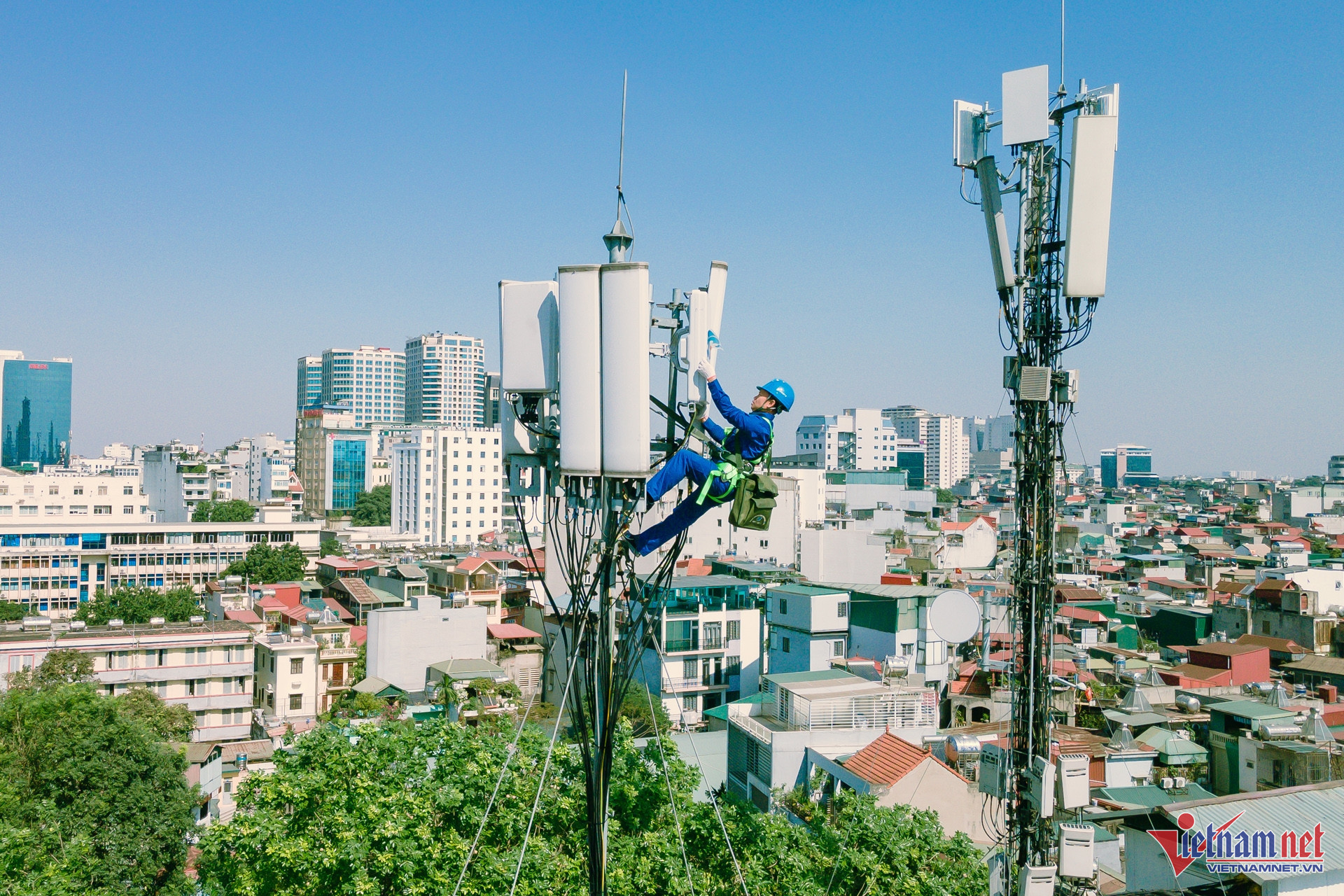Race to the top of thorns
The Draft Political Report of the 14th National Party Congress sets very high targets: In the period of 2026-2030, the growth rate will be 10%/year or more; GDP per capita by 2030 will reach about 8,500 USD; social labor productivity growth rate will reach about 8.5%/year; total social investment capital will average about 40% of GDP in 5 years.
Thus, the milestones of becoming an upper-middle-income country by 2030 and a high-income country by 2045 are very steadfast and consistent in the next stage of development.

The unprecedentedly high development goals demonstrate Vietnam's determination and aspiration to reach prosperity. Photo: Hoang Ha
Around the world, the group of 6 billion middle-income countries is in a race to achieve development goals. Many countries, including Vietnam, aim to become high-income countries within the next 2–3 decades.
But the reality is stark: since the 1990s, only 34 middle-income economies have succeeded. Of these, a third were driven by specific factors such as joining the European Union or discovering oil. Another 108 countries (with GDP per capita ranging from about $1,136 to $13,845) remain stuck in the “middle-income trap.”
Since 1970, the average per capita income of a typical middle-income country has stagnated around $8,000, or just one-tenth that of the United States.
Since 2020, climbing into the rich world has become more difficult due to rising public debt burdens, aging populations in developing countries, and growing protectionism in developed countries…
Two Formulas to Prosperity
To overcome the middle-income trap, the World Bank has published the report “World Development 2024: The Middle-Income Trap” (WDR 2024), emphasizing the race against time of middle-income countries in reforming the development model according to two major pillars of action:
First , countries need to implement a phased development strategy, known as the “3i” strategy, which includes three consecutive policy phases: investment, infusion, and innovation.
This formula, simply put, is that each country needs to sequentially apply different policy focuses:
(i) At the low-income stage, the country should focus on investment promotion policies to build basic production capacity.
(ii) When reaching the lower middle income level, it is necessary to “shift” to the “2i” strategy = investment + absorption: maintaining high investment, at the same time absorbing new technology from abroad and widely disseminating it in the domestic economy. Infusion includes importing modern technologies, ideas, and business processes from outside and diffusing them domestically to improve productivity.
(iii) At the upper middle-income threshold, the country needs to “shift gears” again to enter the “3i” stage = investment + absorption + innovation, that is, combining domestic innovation with investment and absorption. At this stage, in addition to continuing to borrow technology, the country must begin to innovate and create itself – that is, push the global technological frontier further instead of just following.

Vietnam should focus on developing domestic technological capacity. Photo: MH
Second , the report argues that societies that want to innovate need to balance three economic forces: creation, preservation, and destruction. Countries must curb vested interests that stifle competition, reward talent and efficiency, and use times of crisis to push through difficult reforms.
The report notes that many middle-income countries have failed because of outdated or poorly timed development strategies. Too many countries have relied too long on investment alone, failing to change their models; or, conversely, have rushed to promote innovation without sufficient foundation. The result is a slowdown in growth and stagnation. A new and timely approach is needed: First, focus on investment; then emphasize technology acquisition; and finally, balance investment, acquisition, and innovation.
In addition, society needs to know how to harmonize the "creative, conservative and eliminating forces" in the economy - that is, to promote factors that create new values (creativity), restrain conservative forces that hinder competition, and accept the elimination of outdated things for innovation.
Implications for Vietnam
The World Development Report 2024 offers many valuable lessons for Vietnam on its journey to becoming a high-income developed country by 2045.
In fact, WDR 2024 directly refers to Vietnam's Socio-Economic Development Strategy 2021-2030, which targets an average GDP growth of 7% per year this decade and aims to reach high-income status by 2045.
To make that vision a reality, Vietnam needs to take the “3i” recommendations seriously. Currently, Vietnam is at the lower middle-income threshold, so the appropriate strategy is to shift from a model based solely on investment (1i – investment) to a model that also includes technology acquisition (2i – infusion).
Vietnam has been very successful in attracting foreign direct investment (FDI) and has become an important link in the global supply chain in a number of industries (electronics, textiles). This is a good foundation for phase 2i.
However, the challenge is how to make domestic enterprises and Vietnamese workers absorb and spread technology from FDI better - avoiding the situation of "cheap processing" for a long time. Vietnam should focus on developing domestic technological capacity: encouraging links between FDI and domestic enterprises, requiring a gradual increase in the localization rate, investing in vocational education and engineering so that Vietnamese people can master technology. Only then can the economy increase productivity and climb to higher value levels instead of remaining at the processing and assembly stage.
In addition, Vietnam needs to prepare for the second transition to phase 3i (innovation) when it is ready - possibly in the 2030s. This means laying the foundations for the innovation system now: Investing in research universities, building national innovation centers, and promoting technology entrepreneurship.
However, the report also warns against rushing to “burn the stage”. In the immediate future, Vietnam should still prioritize upgrading technology through international cooperation and learning (infusion), because there is still a lot of room for absorption. Only when it has reached the high-tech level (entering the upper middle-income group) should it accelerate strong investment in world-leading fields.
In this roadmap, policy discipline and timing are important - as WDR 2024 writes: Vietnam and similar countries “will have to become more disciplined, and must time the shift from a simple investment strategy to more technology acquisition, before devoting large resources to innovation”.
However, for Vietnam, we need to learn another “i” which is Implementation. The implementation stage is always the weakest stage. Looking back at the past, we have had many good resolutions and great aspirations but failed - the clearest example is the missed goal of industrialization and modernization by 2020. The development goals for the period 2026-2030 are very ambitious, but if not well organized and implemented, it will be very difficult to succeed.
In terms of institutions and business environment, WDR 2024 suggests that much remains to be done to avoid the institutional middle-income trap.
First, it is necessary to continue to expand the space for competition - that is, to limit monopolies and privileges. In Vietnam, the state-owned enterprise sector and crony enterprises still hold many resources. The report warns that protecting state-owned enterprises or favoring "backyard" enterprises can stifle innovation and overall efficiency. Vietnam should study the experiences of other countries: make state-owned enterprise activities transparent, effectively equitize enterprises that the state does not need to hold, and at the same time create a level playing field for the private sector to access previously monopolistic sectors (electricity, energy, telecommunications, etc.).
Institutional reform also includes improving the effectiveness of the legal and judicial systems to protect property rights and enforce contracts - key factors for businesses to confidently invest long-term and innovate.
One point raised by the report that Vietnam should take note of is to avoid extreme policy thinking about business size. Vietnam has long had many programs to support small and medium-sized enterprises (SMEs). Although it is very necessary to support startups, widespread support for small businesses (instead of supporting new, innovative businesses) can reduce productivity and distort resource allocation. Vietnam needs to distinguish between “small” and “new”: it should encourage new businesses with new ideas, rather than maintaining small but ineffective businesses just for the sake of quantity.
At the same time, we need to recognize the positive role of large enterprises: instead of discriminating against large private corporations, we should create conditions for them to compete fairly and expand internationally - as long as they follow the rules of the game. Reward success, handle failure: businesses that operate effectively and contribute a lot should be honored; businesses that suffer long-term losses should be allowed to go bankrupt so that resources can flow elsewhere.
In terms of human resource development, Vietnam is highly regarded for its general education, but its university and vocational education have yet to meet the needs of the economy. Vietnam should reform its higher education to be more practical, encourage creativity instead of rote learning, and attract foreign talent.
In particular, Vietnam should make good use of its female workforce, which accounts for a high proportion of its workforce. Although Vietnam has achieved good results in gender equality in education and labor, women are still underrepresented in leadership positions and are subject to some occupational biases. Enabling women to advance, start businesses, and participate in STEM fields will help Vietnam increase productivity and innovation.
Finally, on the environment and climate change, Vietnam has committed to achieving net zero emissions by 2050. Vietnam is participating in global value chains for renewable energy (such as solar panel and storage battery production) to both develop the economy and have domestic clean technology. At the same time, it is necessary to reform the electricity sector towards a competitive market and prioritize clean energy.
The recent decision to stop developing new coal power plants and switch to wind and solar power is the right move. However, to attract private investment in renewable energy, Vietnam needs to stabilize policies and make electricity prices transparent. The phase-out of fossil fuel subsidies should also be phased in, with support for the poor so that no one is left behind when energy prices rise.
In short, Vietnam can learn a lot from the WDR 2024 report - from timely strategic transformation (from 1i to 2i, towards 3i), to institutional reform to create a level playing field, improve productivity through technology acquisition and competition, and ensure equal opportunities for everyone. To avoid the middle-income trap and achieve the 2045 target, Vietnam needs to accelerate and implement in a more synchronous and drastic manner.
Vietnamnet.vn
Source: https://vietnamnet.vn/cong-thuc-3i-va-khat-vong-viet-nam-thinh-vuong-2392829.html




![[Photo] Cultural, sports and media bloc at the 50th Anniversary of Southern Liberation and National Reunification Day](https://vphoto.vietnam.vn/thumb/1200x675/vietnam/resource/IMAGE/2025/4/30/8a22f876e8d24890be2ae3d88c9b201c)
![[Photo] Chinese, Lao, and Cambodian troops participate in the parade to celebrate the 50th anniversary of the Liberation of the South and National Reunification Day](https://vphoto.vietnam.vn/thumb/1200x675/vietnam/resource/IMAGE/2025/4/30/30d2204b414549cfb5dc784544a72dee)
![[Photo] Performance of the Air Force Squadron at the 50th Anniversary of the Liberation of the South and National Reunification Day](https://vphoto.vietnam.vn/thumb/1200x675/vietnam/resource/IMAGE/2025/4/30/cb781ed625fc4774bb82982d31bead1e)


























































































Comment (0)